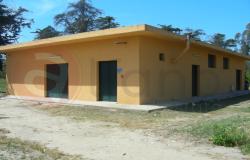The Holy Week in Sardinia is characterised by traditional processions and ancient rituals taking place in various towns and cities around the island. Both devotees and tourists can attend the events organized by the "confraternite" to reenact the last days of Jesus' life until the resurrection on Easter Sunday.
Sa Chida Santa (the Holy Week) begins with sas Prammas, the procession of Palm Sunday. In the following days, various moments from the Passion of Christ are represented through special rituals or processions and Good Friday is devoted to the "Death of Christ". In many towns, the most solemn moments are the ones dedicated to the "Mystery" or to s'Iscravamentu, the act by which the nails from Christ’s hands and feet are removed, then the statue is placed in a coffin and carried in procession.
A great explosion of joy is the main characteristic of Easter Sunday, when austerity gives way to the celebrations of the Resurrection. Applauding, throwing flowers and playing traditional instruments accompany the statue of the risen Christ meeting with that of the Madonna. After the procession, people wish each other “Buona Pasqua” (Happy Easter) and go back home to share a traditional meal with the rest of the family.
Below we suggest three different destinations famous for the Holy Week traditions: Alghero, Iglesias and Cagliari.
Holy Week in Alghero

The Holy Week rituals in Alghero (Setmana Santa de l’Alguer) are among the most striking in Sardinia and are characterised by a strong Catalan influence. Easter traditions date back to the XVI century and are still organised by the old Confraternita della Misericordia (the Brotherhood of Misericordia) also known as “Jermanes Blancs”.
The focus of all the rituals is the Santcristus statue. This wooden statue of Christ, which is taken care of by the Brotherhood of Gonafalone in the Church of Misericordia, landed in Alghero in 1606 during the shipwreck of a ship, the Santa Maria di Montenero, that was heading to Genoa. The wooden Christ of Alicante, Santcristus, that was on that ship floated ashore carried by the waves and became one of the most representative symbols of the local historical tradition, as well as religious and cultural identity of Alghero.
In Alghero, the first procession leaves on Good Friday from the Gothic church of San Francesco of Alghero and continues along the streets with people singing the psalms. This procession is also called “de las dames” because, traditionally, women dressed in black followed the statue of the Blessed Virgin Mary around town.
On Thursday before Easter, Christ's statue is taken from The Church of la Misericordia to Saint Mary's Cathedral where “l'alburament” takes place – the raising of the statue to the centre of the altar which is then guarded by the brothers for the whole night.
On Friday, a mourning liturgy is celebrated in the Cathedral known as missa fugi-fugi followed by the desclavament: four barons dressed in Oriental costumes (representing Nicodemo and Giuseppe d'Arimatea) remove the nails from Christ's hands and feet, and place the statue on a coffin called bressol, a coffin decorated in gold and covered with a transparent veil, and carry it through the streets of the Catalan town lit only by the tiny flames of candles wrapped in red paper called farols and accompanied by folk songs sung by the tenores.
On Easter Sunday, the statues of Christ and the Glorious Madonna are taken in two different processions until they meet in front of a cheering crowd, outside the Misericordia Church, where a solemn Easter Mass takes place in Catalan.
Holy Week in Iglesias

The Holy Week rituals in Iglesias go back to the end of the XVII Century.
The first procession takes place on Tuesday with the procession of "The Mysteries" which includes seven statues representing various moments of the Passion of Christ which are carried around the city streets. A small chair decorated with flowers and olive branches, symbolizing the garden of Getsemani, is followed by Christ imprisoned, Christ scourged, Christ crowned with thorns, Christ walking towards Calvary, Christ crucified, and, finally, the image of the Madonna Addolorata.
On Thursday, right after sunset, the statue of the Madonna is taken into seven churches to visit the sepulchers set up in each church.
A holy procession on Friday reenacts the funeral and burial of Jesus Christ. In this procession, the “Dead Christ” is represented by a wooden statue dating back to the XVII Century.
On Easter Sunday, everyone gathers for S'Incontru (The meeting): The statue of the Risen Christ is taken in a procession starting from the Church of San Francesco while the procession of the Madonna departs from the Church of St.Joseph. The two processions meet in the central square where the two statues bow three times facing each other while the crowd cheers for the resurrection of Christ.
Holy Week in Cagliari

During Easter week, Cagliari, the capital of Sardinia, turns into a natural scenery for rituals and processions which create an intense religious atmosphere.
Celebrations start on the Friday before Palm Sunday when the sacred Procession of the Mysteries, organised by the Brotherhood of the Crocifisso, leaves from San Giacomo Square. The procession of the Seven Statues of "The Mysteries", dating back to the XVIII Century, goes around Cagliari and stops to visit seven different churches.
Every Good Friday The Brotherhood of Solitudine, organises the procession of the “Dead Christ” and the Madonna Addolorata which are taken to Cagliari’s cathedral.
On Easter Sunday, like in Alghero and Iglesias, the people of Cagliari, gather for “S'Incontru” (The Meeting) of the statue of the Risen Christ with that of the Madonna.



